The American Way to Europe - United States Lines - 1924
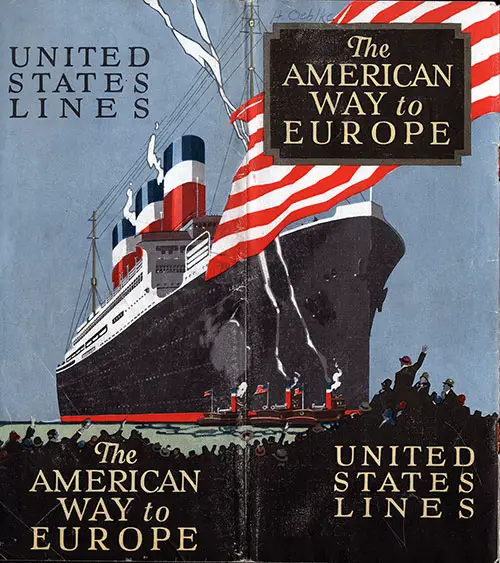
Front Cover of a 1924 Brochure from the United States Lines Entitled "The American Way to Europe. GGA Image ID # 11feaac14c
A comprehensive brochure from the United States Lines was developed to provide information and photographs describing the ships and amenities geared to Americans traveling to Europe. It also contains brief information on sites to see in Europe.
The United States Lines
The United States Lines fleet, the one great American flag service to Europe, comprises six ships — your own ships. They are six of the finest in the world and are operated by the United States government. They offer the most exceptional kind of ocean travel with a variety of passages and accommodations to suit every purse.
There are three distinct services between New York and Europe, with sailings on a definite schedule throughout the year, summer and winter, as follows:
- The great "Leviathan" that sails every three weeks for Cherbourg and Southampton.
- The first-class line to Plymouth, Cherbourg, and Bremen, on which the SS "George Washington" is operated.
- The cabin (one class) ships "America," "Republic," "President Harding," President Roosevelt" which sail to Plymouth, Cherbourg, and Bremen. Regular calls are also made at Cobh (Queenstown).
These ships offer you a variety of passages. There is First Claas, Cabin Class, Second Class, and Tourist Third Cabin. These differ from each other in the degree of luxury which they provide but are similar in one respect. Each offers you the best possible value for your money.
The Fleet
- SS Leviathan
- SS President Harding
- SS George Washington
- SS America
- SS President Roosevelt
- SS Republic
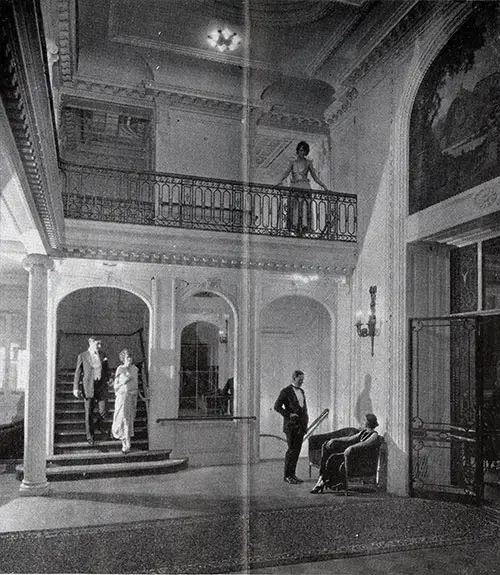
Lobby and Staircase on the SS Leviathan. GGA Image ID # 11fefd5d91
Americans enjoy in their homes a higher standard of living than any other people in the world. In their clubs and hotels, they are accustomed to a higher standard of service. But until the advent of the United States Lines, it was impossible to obtain these same high standards of living and of service afloat as well as ashore.
Now as you pass over the gangway into any one of your own ships you experience all the comfort of home without any of its cares, and all the freedom, luxury, and ease of the best American club or first-class hotel. You cannot, no matter what price you pay, travel to Europe more luxuriously and comfortably.
Write or see the nearest United States Lines office, or see your nearest local steamship agent about rates, deck plans, and detailed information.
First Class
First-Class Accommodations are available on the “Leviathan” and the “George Washington.” Detailed descriptions of these ships are given later in this brochure.
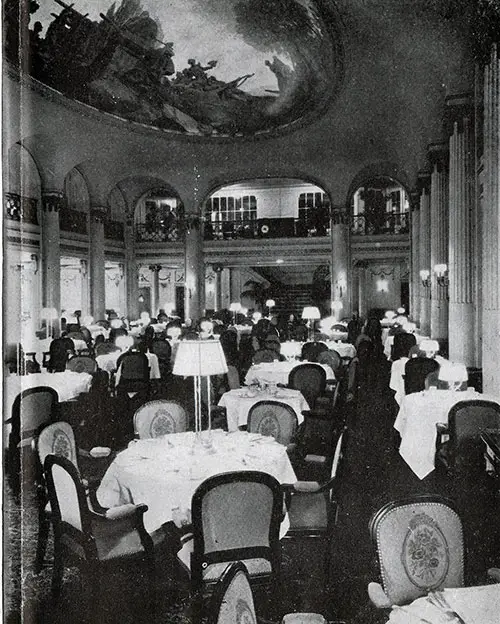
First Class Dining Room on the SS Leviathan. GGA Image ID # 11ff013641
First-Class accommodations naturally differ in detail on the SS Leviathan and the SS George Washington. Each has its own arrangement, its own scheme of decoration, its own individuality, but since each is a part of a united fleet, directed and maintained to fulfill one unchanging ideal, the differences remain differences of detail only.
Go to Europe first class on either the SS Leviathan or the SS George Washington, and you will enjoy the most exceptional transportation in the world.
When you go aboard it is probable that you will be impressed first of all by the main lounge, the largest of all the public rooms and the social center of the ship.
The main lounge on the Leviathan is in the style of Louis XIV and is magnificently paneled in oak. On the SS George Washington, the lounge is decorated in the exquisite style of the French Renaissance with gold figures on dark paneling.
It is in these beautiful settings that all the concerts and dances that make every voyage such a memorable experience take place.
If you are a seasoned traveler, you will immediately appreciate the difference between the reading and smoking rooms of today as compared with those of a decade or two ago. The old institutional severity has given way to beauty, cheerfulness, and modern luxury.
Each of these smoking rooms with its big chairs, open fireplaces and windows looking out across the sea is a man’s club afloat — an ideal lounging place for the comfort-loving male, where he may play cards, smoke, talk, or read in peace, and always be sure of finding congenial fellowship.
The Leviathan’s charming Queen Anne Tea Room with its old English color prints is a delightful place to take tea.
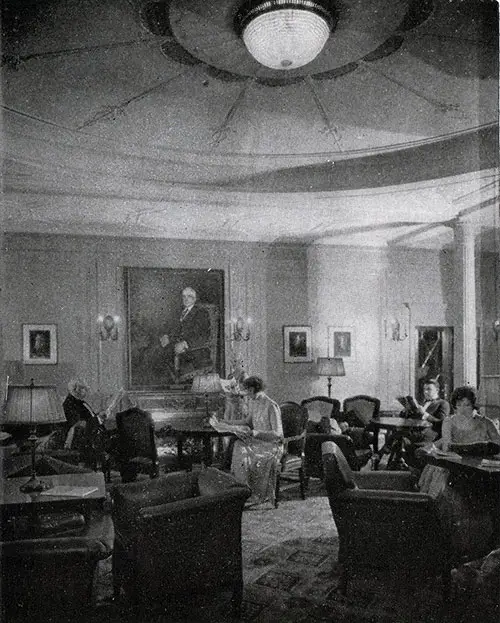
First Class Library on the SS Leviathan. GGA Image ID # 11ff296d77
A competent and helpful librarian is in charge of the first-class library on each ship. Here you will find just the book, classic or latest “bestseller,” to suit your mood.
On the long wide decks, you will spend the greater part of your days — crossing the Atlantic — in your deck chair looking at the “infinite series of the sea,” watching the water swish by below you, drinking in the glorious, refreshing air, reading, walking or enjoying the deck sports.
These sports are a source of endless enjoyment. There are the games to be played by small groups of friends, such as quoits, shuffleboard, deck golf, and deck tennis and there are also the impromptu games organized by the sports director for all who will join. Special provision is made for the entertainment of children.
The cuisine is the most essential item. Indeed, it seems so after a morning or afternoon in the salty sea air. It is just because of this that significant numbers of regular travelers yearly choose the United States Lines. Unequivocally, it has the best cuisine on the North Atlantic.
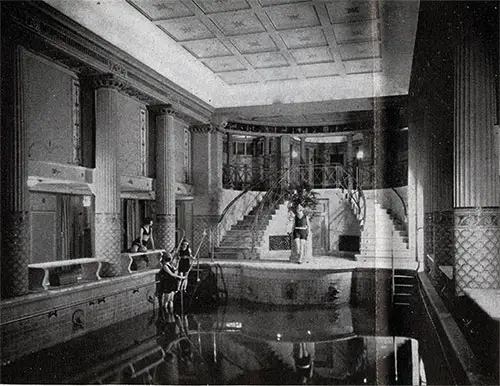
Swimming Pool for First Class Passengers on the SS Leviathan. GGA Image ID # 11ff2982a9
A glance at the specimen menus following will give you a slight idea of the variety of food that is served at each meal. It is the most exquisite food that money can buy and is prepared by famous chefs in kitchens that are clean in the American sense, with modern scientific equipment such as few hotels can boast. There is practically no dish that you cannot have, and your table steward is quick to learn your individual likes and dislikes.
Meals are served in delightful deep carpeted dining rooms, the private tables bright with their silver, flowers and snowy napery, or in your own stateroom. Light refreshments are served on deck between meals.
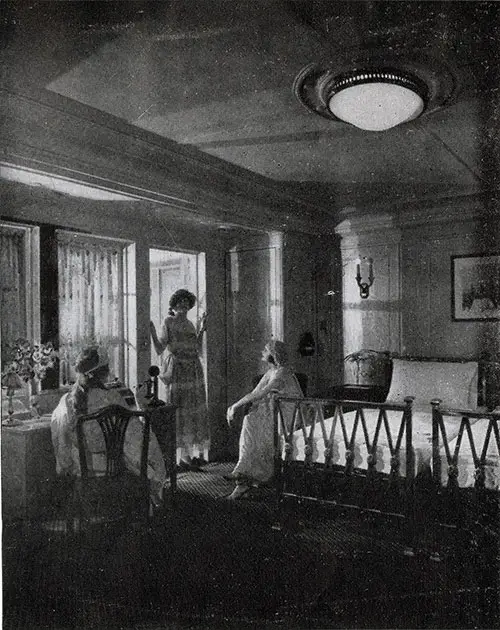
Deluxe First Class Stateroom on the SS Leviathan. GGA Image ID # 11ff438e79
To all who have not seen them before, the first-class staterooms on the SS Leviathan and the SS George Washington are a revelation. They vary in size and location, but even the smallest is at least as large as most first-class hotel rooms. They are tastefully decorated, luxuriously furnished and artistically lighted. Many have private baths.
There are deep, comfortable beds, not berths, and handsome period furniture. Nothing that could possibly increase your comfort has been omitted. Electric fan, telephone, and vacuum bottle in every room. There are exclusive suites deluxe with private bath and parlor that rival the owner's suite on a private yacht.
The perfect steward must be courteous, alert, cheerful, and friendly without presumption or familiarity. He must possess tact, and he must have an accurate memory for his passengers' preferences. It has been the purpose of the United States Lines to seek out such men and hold them in its service — in your service.
One of the wonders of modern steamship travel is the magnificent Pompeian swimming pool on the Leviathan. All United States Lines ships have fine gymnasiums, equipped with the most modern apparatus, including electric horses, rowing machines, punching bags, chest weights, and massage tables. A competent physical director is in attendance.
The SS Leviathan and the SS George Washington are especially noted for seaworthiness and steadiness. They are great favorites of experienced Atlantic "commuters."
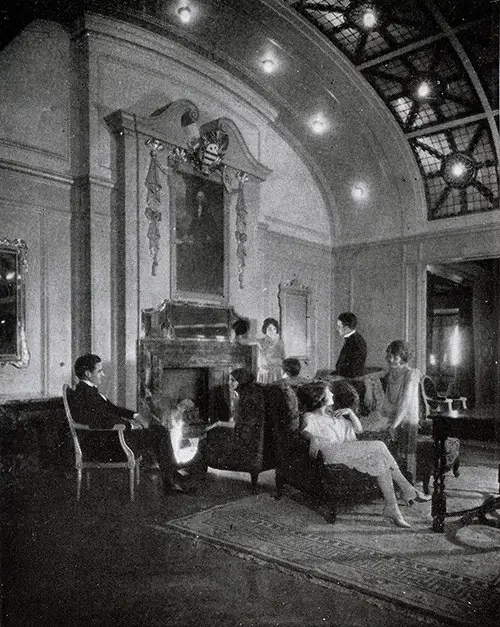
First Class Social Hall on the SS George Washington. GGA Image ID # 11ffea0c9a
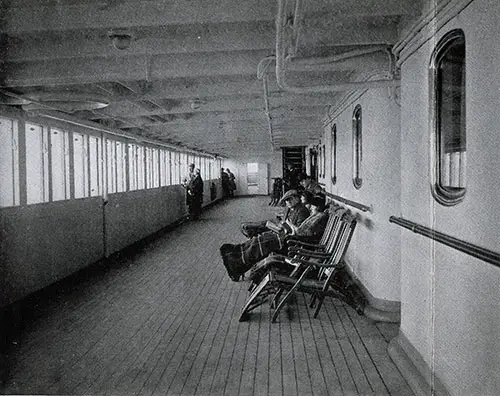
Enclosed Deck for First Class Passengers on the SS George Washington. GGA Image ID # 11ff8e6afc
Cabin Class
One of the most significant trends in steamship history during the last few years has been the increase in popularity of the “Cabin” one class ships. These ships are without any first or second class distinctions.
There are no restrictions of any kind, and every Cabin passenger has the freedom of the entire vessel. Just as in an American hotel, there are differently priced accommodations, but all guests enjoy the same privileges and the same service.
Rates are slightly higher than the second class and materially less than first-class rates.
Among all the Cabin ships that sail the seven seas, you will find no more exceptional vessels than the four that fly the United States Lines flag.
- SS America
- SS President Harding
- SS Republic
- SS President Roosevelt
For all-round performance and uniform excellence of service, these four ships are in a class by themselves. Yet each one makes its own individual appeal to the experienced traveler. Each has its own personality.
The “America” is the largest Cabin ship in the world, with the reputation of being one of the steadiest. The “Republic,” almost as large as the “America” is undoubtedly a sister ship as far as comfort is concerned and is every bit as popular. The well known “President Harding” and “ President Roosevelt” are the fastest Cabin ships on the Atlantic and make the crossing between New York and Plymouth in seven days without hurrying.
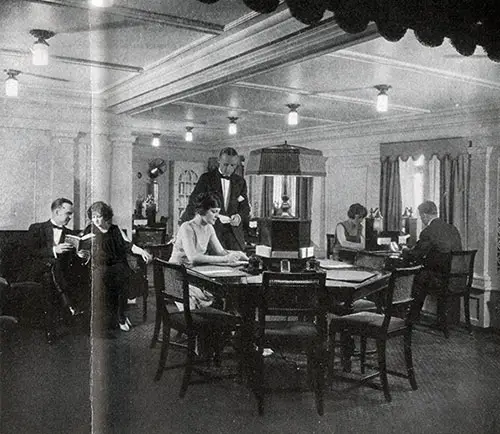
Cabin Class Writing Room on the SS President Roosevelt. GGA Image ID # 120017a5a9
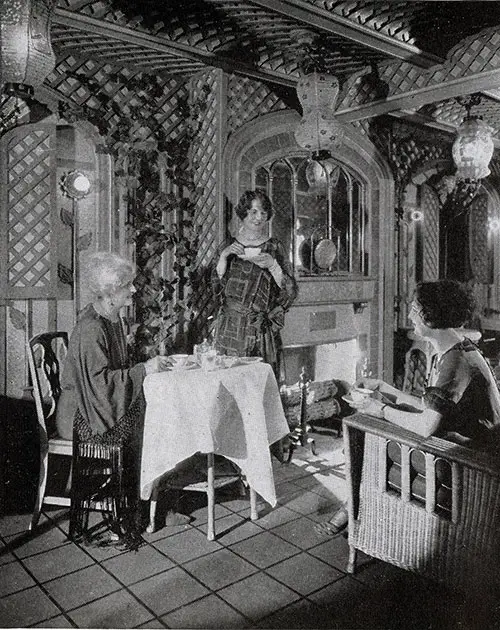
Cabin ClassTea Room on the SS President Harding. GGA Image ID # 120037856c
While not as speedy as the "President" ships, the "America" and "Republic" are particularly popular for that very reason, with many who prefer to spend a day or two longer gaining health at sea.
The pictures on these pages, taken aboard the four above mentioned Cabin ships of The United States Lines, give some slight indication of the elegance and refinement that has made these ships so popular.
If their public rooms are less impressive than those on the bigger first-class vessels, the difference is one of size alone. Indeed, no hotel or club offers more comfortable or more attractive surroundings to its guests or members.
Where will you find a better place to play cards and to relax with a well-tried pipe, or a fragrant cigar than in the SS America's smoking room?
The smoking room's oak ceiling, oak paneling, tapestried chairs, and open fire create the sensation that you are sitting in some quiet old English Manor house.
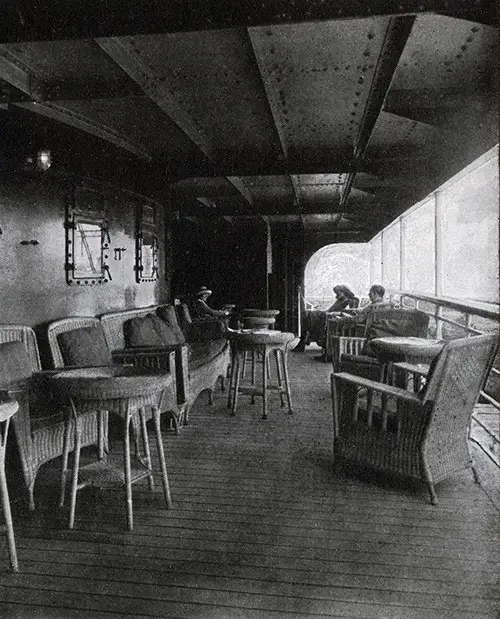
A Classy, Relaxing Deck Verandah on the SS President Roosevelt. GGA Image ID # 120046a2ee
Where will you find dignity made more attractive than in the white paneled dining room where the lavish hospitality and Virginian cooking of Washington’s day are so well duplicated? Where could youngsters be happier than in the Children’s Playroom, the cheeriest nursery you ever saw? And where but on one of these cabin ships will you find such attractive staterooms at such attractive rates?
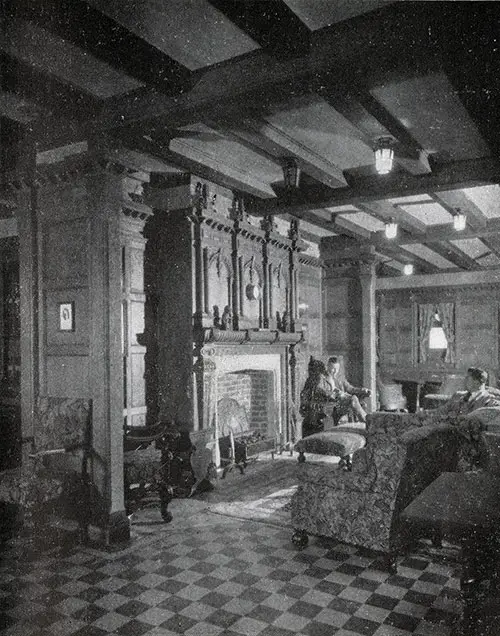
Cabin Class Smoking Room on the SS America. GGA Image ID # 1200da121a
On the SS “President Roosevelt” and the SS “President Harding,” all the staterooms are outside rooms — cool, airy, and spacious. They are appropriately furnished in the style of the Colonial period — always charming and particularly popular just now. They have garden-like tea verandahs that add significantly to the pleasure of afternoons at sea.
All rooms on the Cabin Ships have the large clothes closets that women appreciate—thermos bot- bottles — electric fans — bed reading lamps—everything to preserve the comfortable atmosphere of home — even in mid-Atlantic.
The lounges tempt you to stay in almost as much as the decks tempt you out. They have suffused lights, broad windows instead of portholes, beautiful floors, rugs and period furniture. In winter the long, expansive decks are glass-enclosed. You can go for a pleasant walk, or enjoy deck sports whenever the spirit moves you.
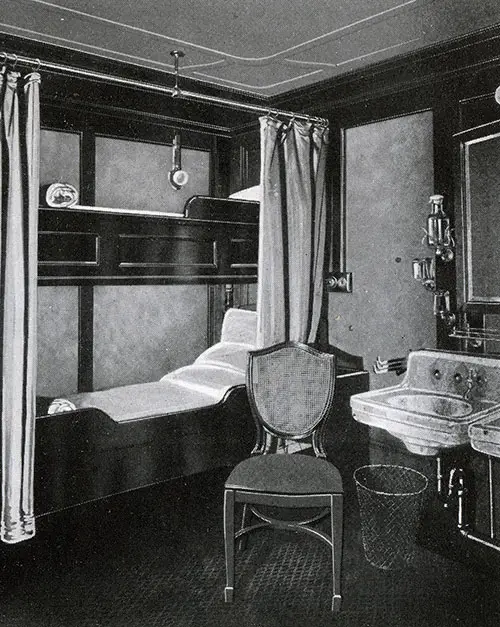
A Cabin Class Stateroom. GGA Image ID # 1201082b82
Every ship possesses an excellent library in charge of a helpful, well-informed steward. An accomplished orchestra provides music during meals, during afternoon tea in the lounge and for dancing at night.
There is always plenty to do if you want to do it, and there is nothing at all to do if you prefer to be comfortably idle.
Compare the first class menus printed below with the Cabin class menus and notice how little they differ. Hardly a single dish that you can think of that isn't ready to be brought to you, temptingly cooked and served by a courteous steward, anxious always to see that your appetite, whether hungry or epicurean, is completely satisfied.
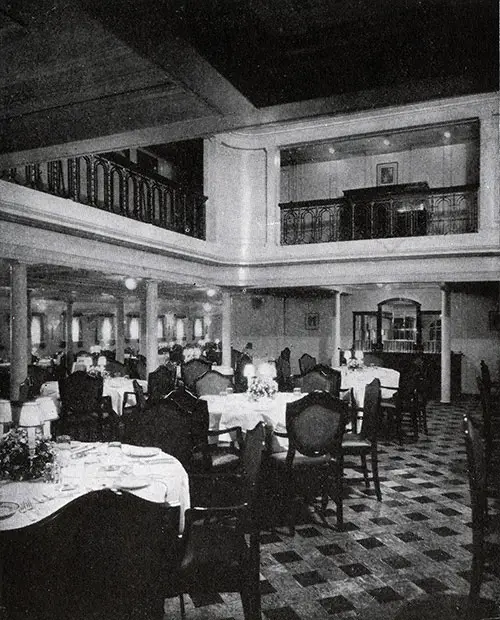
Cabin Class Dining Room on the SS America. GGA Image ID # 1201546b97
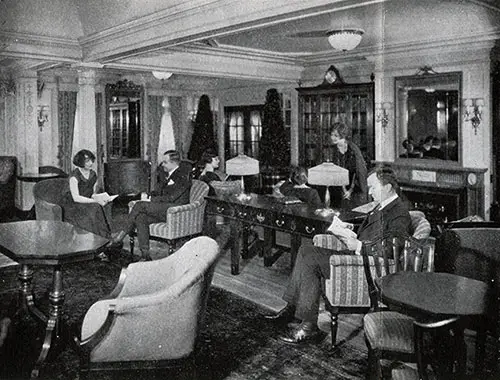
Cabin Class Social Hall on the SS Republic. GGA Image ID # 1201a201bf
Expert chefs prepare your meals in modern, spotless kitchens, equipped with every modern improvement. And thanks to modern refrigeration methods, fresh vegetables, and dairy products are available at all times. Light refreshments are served on deck and in the lounge between meals. In short, the best cuisine on the North Atlantic.
Both the SS "America" and SS "Republic" have completely equipped gymnasiums in charge of a physical director and afford excellent facilities for health-giving indoor exercise. All four ships have modern, hygienic barber-shops.
Every year sees an increase in the bookings of these ships, appealing so strongly as they do to that great body of Americans of refined taste that does not want the outlay for steamship passage to drain too profoundly into the sum set aside for the European tour. It is wise to make reservations well in advance.
Specimen Menus
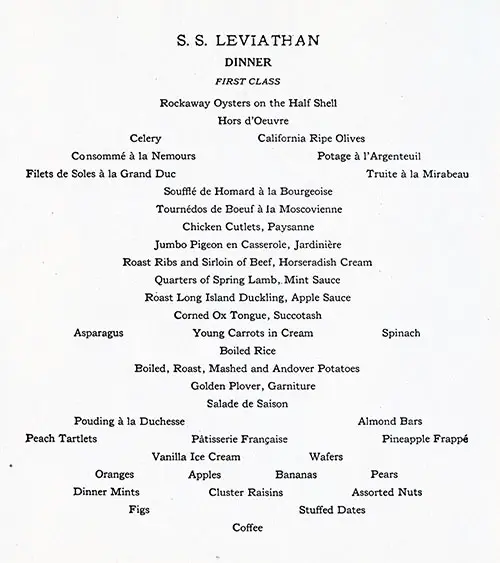
Sample First Class Dinner Menu on the SS Leviathan. GGA Image ID # 1201dfa9d3
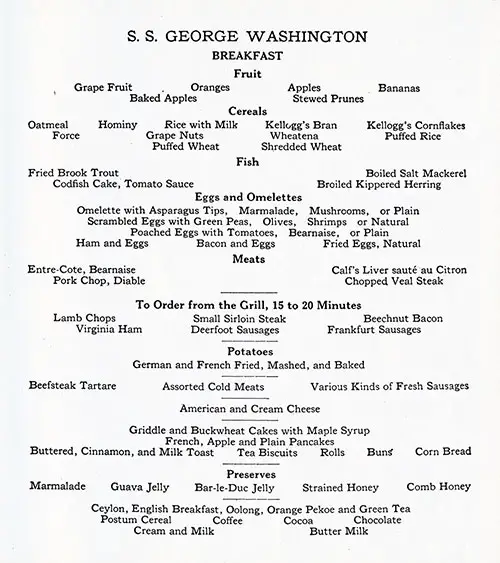
Sample First Class Breakfast Menu from the SS George Washington. GGA Image ID # 1201e04410
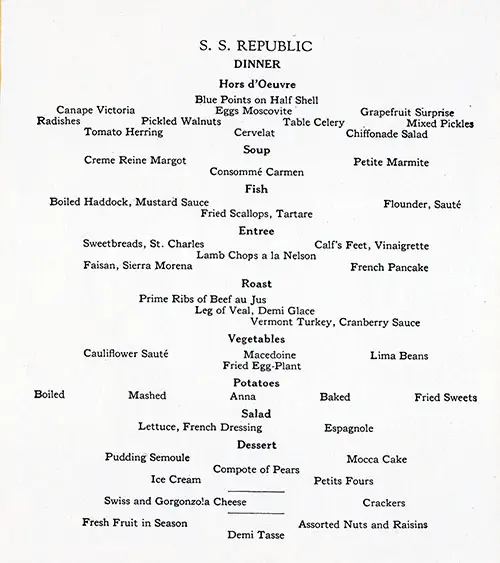
Sample Cabin Class Dinner Menu from the SS Republic. GGA Image ID # 1201ec409d
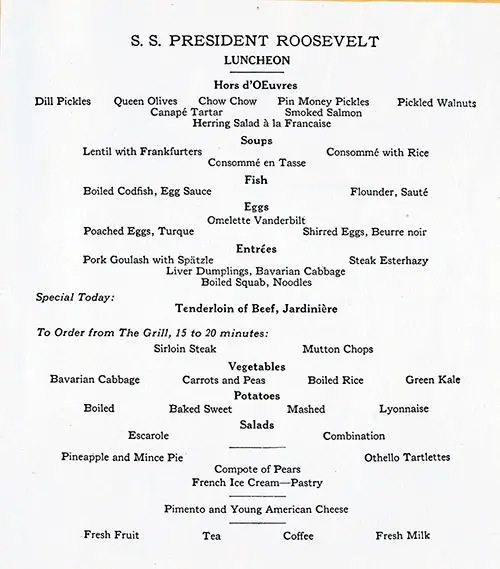
Sample Cabin Class Luncheon Menu from the SS President Roosevelt. GGA Image ID # 1201ee6604
Second Class
For the American who wants to go abroad amid every modern American convenience on a vessel noted for speed, luxury, refinement of service, and its sea-going qualities, the Second Cabin offers an unusual opportunity at low cost.
Likewise, for those who are not influenced by considerations of fashion and for the many Americans of taste and intelligence who wish to conserve the outlay for steamship passage, this is the ideal way to go.
Second Cabin accommodations on United States Lines Ships are in keeping with the great democratic principles of our country. “Class” distinctions in the European sense are entirely lacking.
The Second Cabin merely means less expensive rates and slightly less luxurious accommodations. In the Second Class on such crack ships as the great Leviathan and the palatial George Washington, you enjoy such luxury and comfort as was unknown in the First Class just a few years ago and is lacking even now in the First Class of many smaller liners.
Some people think that Second Cabin passengers have to be content with only one deck and that a lower one. But this is the reverse of true. The Second Cabin has a complete section of the ship to itself including part of several decks. These are both broad and long. There are plenty of quiet nooks and room for deck sports and impromptu dances.
The lounges are deeply carpeted, and beautifully furnished for luxurious rest, reading, letter writing, and intimate conversations. Tea is served each afternoon during the concert given by the ship’s orchestra. A generous library with a helpful steward in charge offers you the best books of the day.
The dining rooms are decorated in quiet tones, and the tables seat four people each. No effort is spared to appease the hungry appetite one has on board ship.
The modern magic of refrigeration makes it possible to provide everything from meats to eggs, with milk and vegetables as fresh as on the farm. The cooking is expert and the service courteous and meticulous.
Second Cabin staterooms are unusually large, with high ceilings and wide berths and fitted with every essential toilet requisite. Efficient steward and stewardess service night and day.
Tub baths with both salt and freshwater are available under conditions of absolute privacy for both men and women at all times. Both ships have modern gymnasiums and barber-shops.
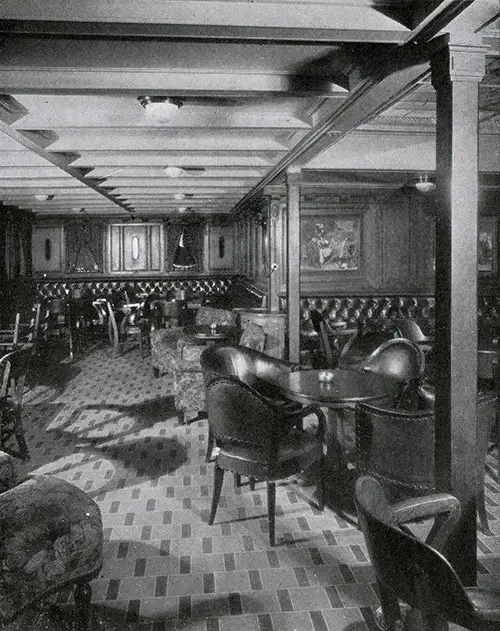
Second Cabin Smoking Room on the SS George Washington. GGA Image ID # 1202012bbb
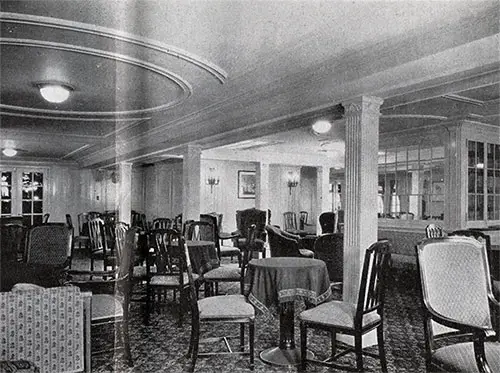
Second Cabin Social Hall on the SS Leviathan. GGA Image ID # 120212eca9
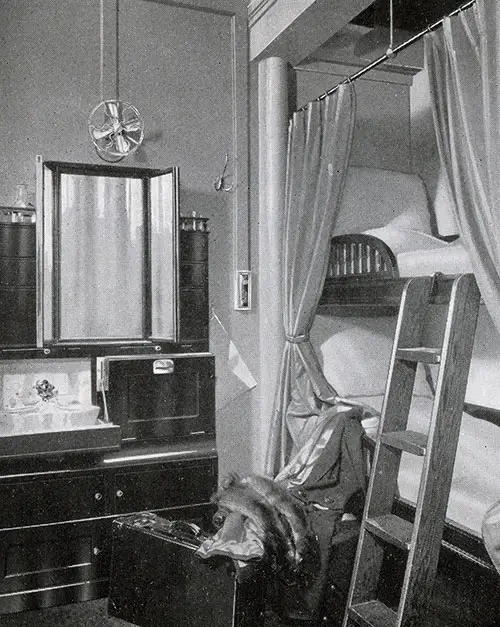
Second Cabin Stateroom. GGA Image ID # 12022ca8f8
Tourist Third Cabin
Tourist Third Cabin — the most significant travel innovation of our times — needs no introduction. Every year, thousands more people, young and old, are traveling this economical way to Europe and telling their friends what a marvelous idea it is.
You experience Tourist Third Cabin travel at its best on United States Lines Ships. There are staterooms to accommodate two, four, and six people. They are large, light, airy, and always kept spotlessly clean. The beds have deep comfortable mattresses, spotless linen and plenty of warm blankets.
The deck space is ample and well arranged with plenty of room for dancing and deck sports. The reading and smoking rooms for men and women are well furnished and comfortable, and the library has just the book to suit your mood.
Everyone is surprised by the quantity and quality of the food that is served in the sizeable cheerful dining rooms. The food is plain, but it is of the best quality and very well cooked. You may have just as much as you want, and a courteous steward will be quick to see that you lack nothing.
Thousands of travelers have crossed in the United States Lines Tourist Third Cabin, many of whom were women. Writers of national and international fame, university professors, instructors, ministers, priests, lawyers, doctors, elementary and secondary school teachers, college students, tourists, American businessmen, many accompanied by their families have selected the United States Lines.
Economy means making the most of what resources one has. The American Way Tourist Third Cabin to Europe makes this kind of economy possible. It also makes a trip to Europe not an undertaking of great difficulty, but quite the contrary — even after the traveler has reached his destination.
European travel may be divided into three categories, namely: Independent Travel, Inclusive Independent Travel and Conducted Tours at prices ranging from $275.00 for two weeks in Europe to $645.00 for an eight weeks’ tour including Tourist Third Cabin round trip ocean accommodations, and all other necessary expenses.
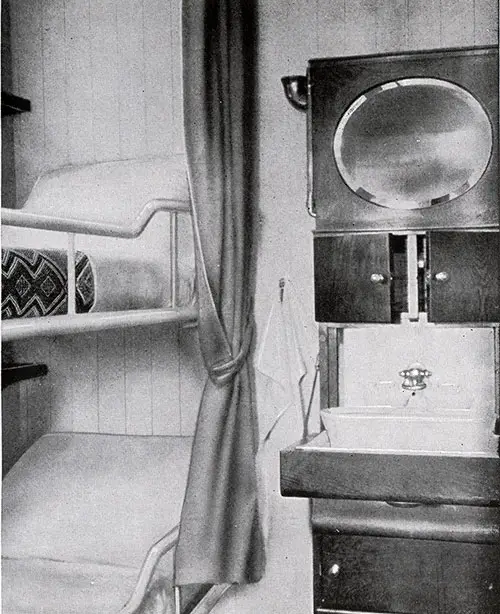
Tourist Third Cabin Stateroom. GGA Image ID # 1202c6cbfd
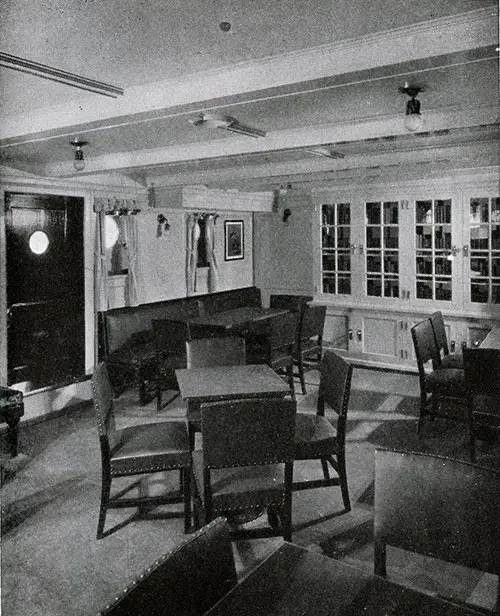
Tourist Third Cabin Social Hall on the SS Republic. GGA Image ID # 1202fa9067
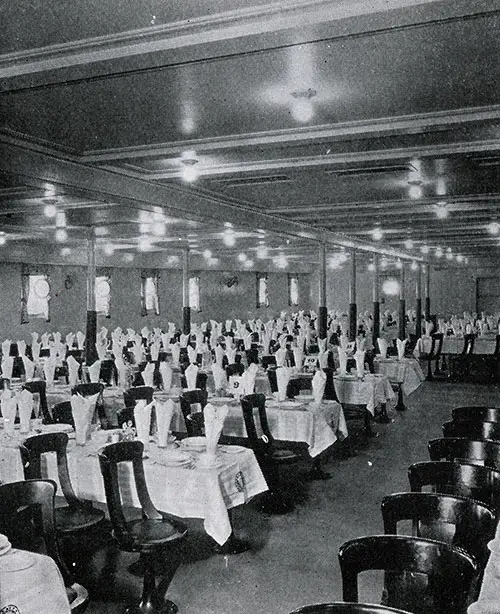
Tourist Third Cabin Dining Room on the SS Leviathan. GGA Image ID # 12036d0f12
The Independent Traveler proceeds at will without making any advance arrangements. This allows the utmost freedom and independence of action.
Inclusive Independent Travel is very satisfactory to those who wish to be independent of any party, but still, desire to have all arrangements made for them.
Conducted Tours are the easiest and certainly the most efficient way of seeing Europe in a short time. They may be arranged for practically any part of Europe, and full information will be furnished by the United States Lines in answer to any request for an itinerary.
The United States Lines issue a special illustrated booklet containing all desired information on Tourist Third Cabin. It may be obtained on request from branch offices or agents.
The offices of the United States Lines throughout Europe are always ready to smooth the way for the traveler. They furnish reliable information as to rooms, locations, routes, train time, etc., and are always prepared to give competent advice to the tourist traveler. Mail can be sent abroad in care of the United States Lines offices.
United States Lines Photo Gallery
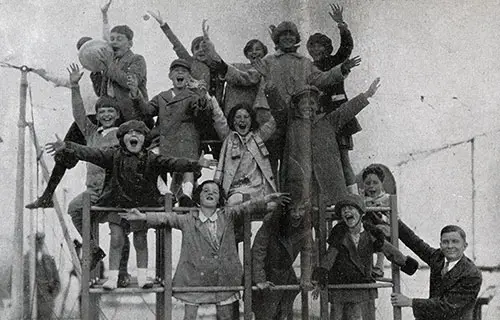
Youthful Passengers Enjoy a Happy Vacation at Sea a Marvelous Experience for a Child! GGA Image ID # 12038e8487
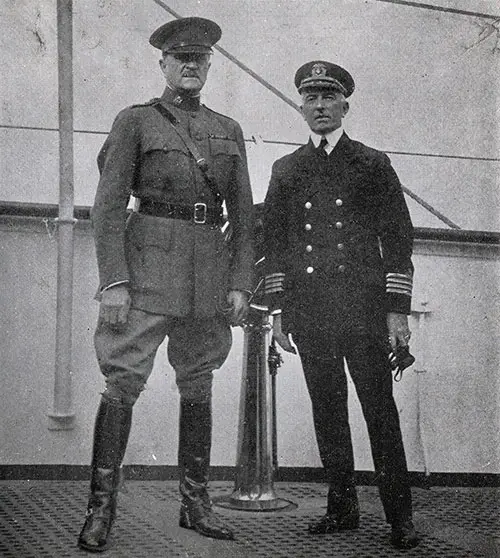
General Pershing and Captain Cunningham on the Bridge of the Great Liner SS George Washington. GGA Image ID # 1203b1b90b
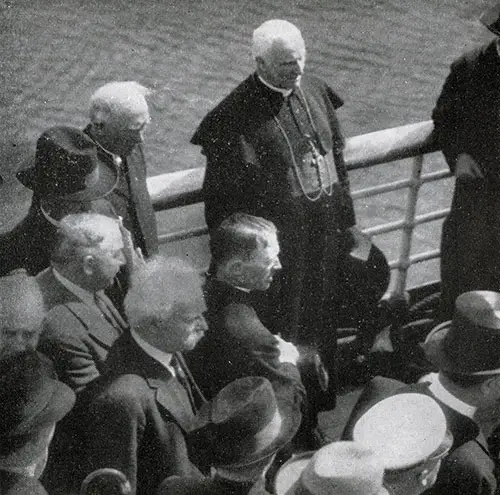
Cardinal O’Donnell, Primate of Ireland, Arriving in America on Board the SS Republic. GGA Image ID # 1203c0bc27
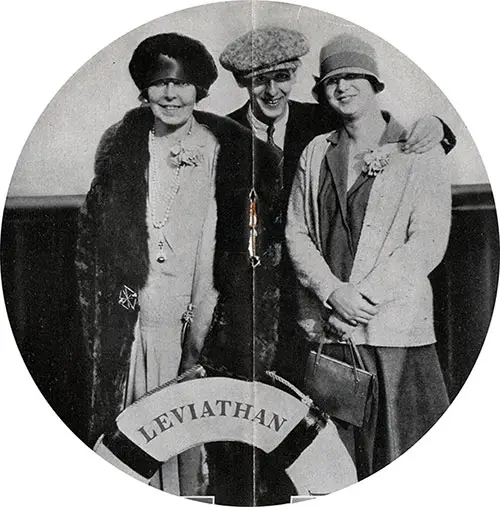
Queen Marie of Romania, Princess Ileana, and Prince Nicholas on the SS Leviathan. GGA Image ID # 1203e46c95
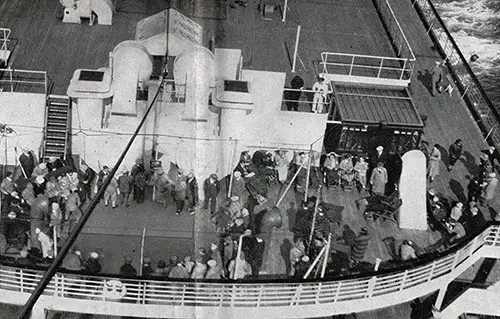
A Country Club in Mid-Ocean! One of the Huge Roomy Decks of a United States Lines Ship. GGA Image ID # 1203e60be0
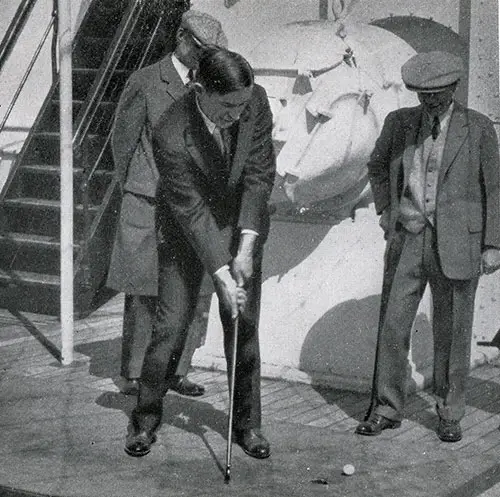
Will Rogers Tries for the Golf Championship of the Atlantic but Misses His Putt. GGA Image ID # 1203f8c2df
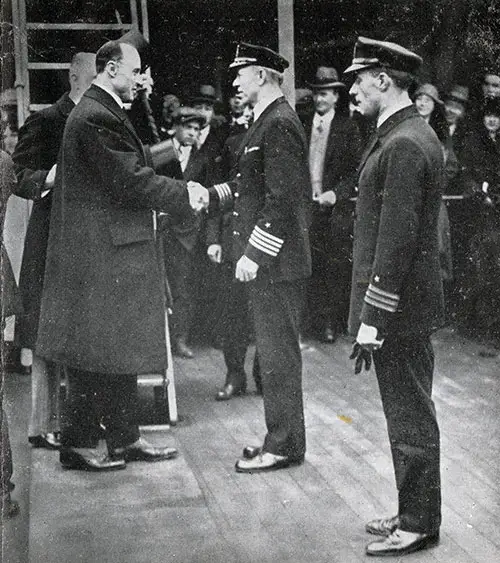
Captain Fried of the S.S. President Roosevelt Congratulated by a Representative of King George. GGA Image ID # 120462f14d
Ships of the United States Lines
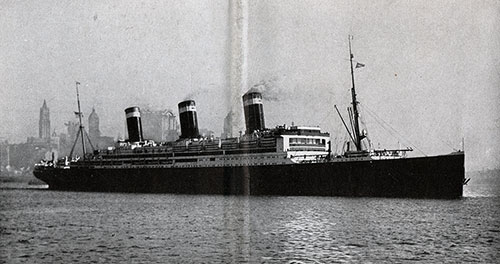
The SS Leviathan, Flagship of the United States Lines. GGA image ID # 12047c06fe
THE SS LEVIATHAN, from stem to stern measures 950.7 feet. Placed on end the ship would rise to almost twice the height of the Washington Monument.
The Woolworth Building, the highest building in the world, could be laid alongside this vessel and the Leviathan would have 175 feet to spare! The Leviathan is the largest ship in the world. Her gross tonnage is 59,956.65.
The Leviathan has created new standards of trans-Atlantic travel, and only those who have been on board can appreciate the luxury and elegance of her appointments.
Staterooms, social halls, dressing rooms, smoking rooms, libraries, music rooms, dining rooms, tea rooms, gymnasiums, swimming pool, and baths all represent the supreme triumph in shipbuilding and ship decoration.
The Leviathan makes the voyage from New York to Cherbourg in approximately five days and six hours.
Among unusual features of the Leviathan are a telephone in each first-class stateroom, moving picture feature films, and a heating, lighting and plumbing system that is the last word in American ingenuity.
The social hall, smoking room, library and other rooms for the use of all passengers are open 24 hours a day, as against the common custom of closing such places at midnight.
When the great ship was rebuilt, the architects avoided that tendency successfully towards the over-ornate, which was formerly characteristic of marine interiors.
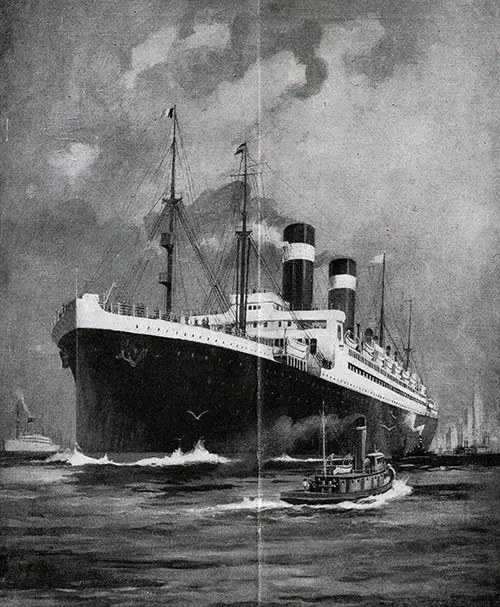
The SS George Washington of the United States Lines. GGA Image ID # 1204ba8405
THE SS GEORGE WASHINGTON is 722 feet long, with a gross registered tonnage of 23,788 and a total passenger capacity of 1,888. It ranks as one of the finest vessels in the trans-Atlantic service and arrives in Plymouth seven days after leaving New York.
The American talent for combining beauty and charm is apparent all through the George Washington.
One sees it in the smoothly running elevators, supplementing the beautiful stairways ; in the frequent use of Colonial windows rather than the conventional portholes ; in the beds which have supplanted the usual berths, and in the pleasing decorations.
The George Washington is widely known for her steadiness. She has triple promenade decks, a gymnasium and two smoking rooms. The Presidential suite used by the late President Wilson and the King and Queen of Belgium exemplifies the excellence of the ship’s accommodations.
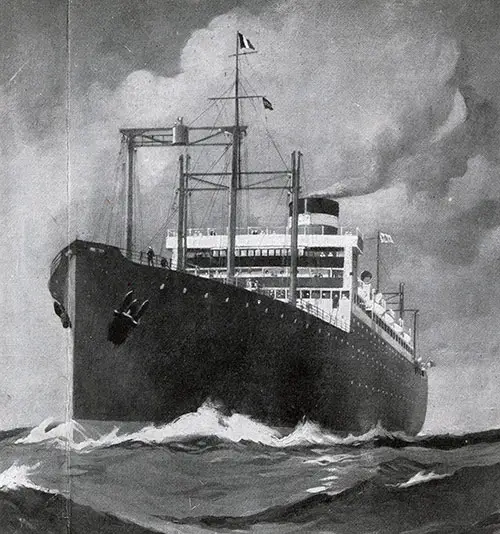
Sister Ships SS President Harding and SS President Roosevelt. GGA Image ID # 12052d34aa
The SS PRESIDENT HARDING AND THE SS PRESIDENT ROOSEVELT, two famous sister ships are the fastest cabin ships on the Atlantic. They are operated between New York and Plymouth, Cherbourg, and Bremen, making the voyage to Plymouth in seven days.
Of such ships, it is challenging to speak temperately. Whoever is familiar with the sea is conscious of the fact, axiomatic among seafaring folk, that ships are endowed with a definite personality.
They have almost human traits — subtleties of behavior, peculiarities of physical appearance, a perfectly tangible, but indefinable individuality which is instantly apparent.
For this reason, we need not fear the charge of exaggeration in characterizing the SS President Harding and the SS President Roosevelt as eminently delightful ships.
These popular ships are 535 feet in length. They are oil-burners of 21,167 displacement tons and 14,187 gross registered tons. Seven watertight compartments protect the bow alone. The vessel could be cut in half, and both halves would float.
The SS President Harding and the SS President Roosevelt as sister ships are alike in most details and are noted for their safety and seaworthiness.
Wide veranda-like decks, intimate tea-rooms, homelike smoking rooms, dining salons and social halls that are masterpieces of the decorator’s art, are features of these liners.
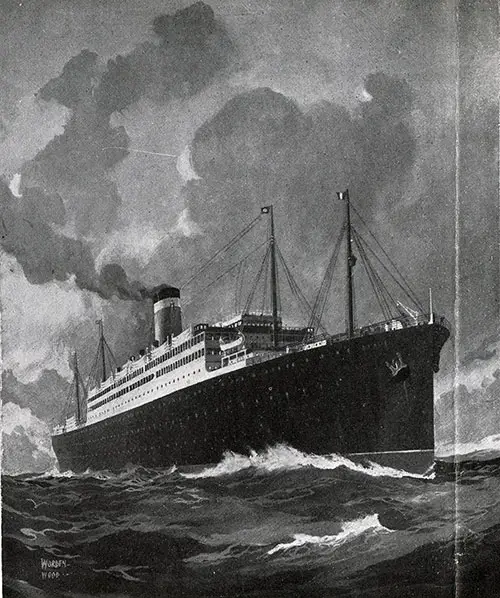
The SS Republic of the United States Lines. GGA Image ID # 12052f05d8
THE SS REPUBLIC, the newest addition to the fleet of the United States Lines, has assumed an essential place in the trans-Atlantic service as a running mate to the SS America.
The SS Republic is of 18,000 gross registered tons, and her length overall is 615 feet. This great newly reconditioned ship has accommodations for 614 cabin and 1,100 third-class passengers. The Republic makes the trip to Plymouth in eight days.
The public rooms, the social hall, smoking room, veranda, tea room, dining salon, and gymnasium are the very last word in refinement, beauty, and completeness of equipment.
This new ship embodies the latest developments in modern shipbuilding. Every known device for luxury and safety has been included in its equipment. Its public rooms are spacious and tasteful, and broad promenade decks give ample room for invigorating hikes and for deck sports and impromptu dances.
In the cuisine and service of this new ship are retained the high standards set by the rest of the fleet and for which the United States Lines are justly famous.
All staterooms are comfortably and tastefully furnished. And with all this luxury and completeness of equipment, the minimum passage rate on the Republic is exceptionally low.
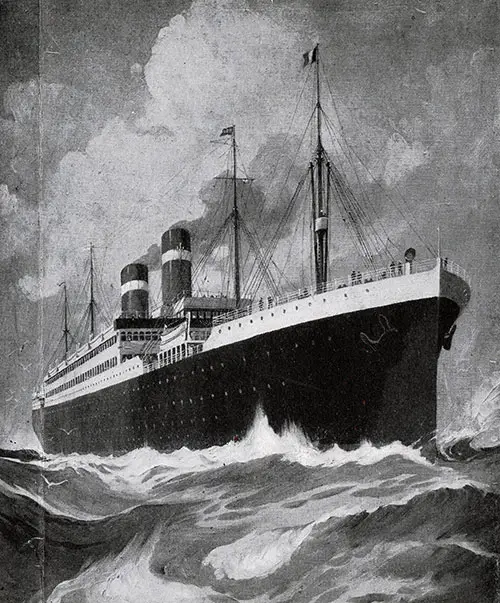
The SS America of the United States Lines. GGA Image ID # 12055405f3
THE SS AMERICA is second in size only to the SS Leviathan and the SS George Washington.
This greyhound of 21,144 gross registered tons has the reputation of being one of the steadiest vessels afloat. The staterooms and public rooms on this “cabin” ship are remarkably spacious and light and cheerful in tone.
The refined tone of the SS America’s appointments and the high quality of its decoration are a delight to the passenger. Here we find the valuable skill of modern shipbuilding aimed toward securing an abundance of room, light, and air for all on board.
The SS America is the largest as well as one of the most luxurious of “cabin” ships. She cruises between New York, Plymouth, Cherbourg, and Bremen, arriving at Plymouth in seven days.
All the staterooms are spacious and attractively furnished. The old-time heaviness so prevalent in the decoration of ocean liners in the past has been supplanted with the typically American lightness of surroundings that goes far to make one’s journey pleasant.
SS America is equipped with an excellent library, wind-screened decks, and a spacious ballroom.
The SS America is also provided with the best- known safety devices, including water-tight bulkheads and a double bottom extending the entire length of the ship and divided into 26 compartments.
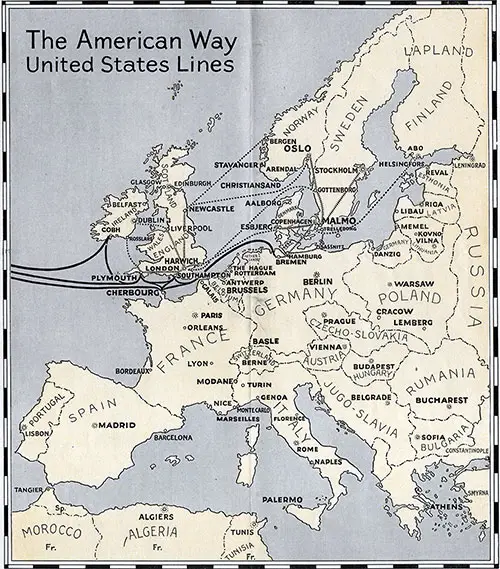
The United States Lines Route Map - The American Way to Europe. GGA Image ID # 1205d48133
You're Going To Europe!
How to get ready, what to take, expenses, hints on itineraries
YOU'RE going to Europe! The first thing to do is to make sure of your accommodations. Mail your check for 25% of passage rate at once to reserve those you select.
Make a note on your desk pad that the balance due on your passage must be paid four weeks before the sailing date. And right here is an excellent hint. Make your reservations for your return trip also, and save yourself the trouble later.
Probably you have a general idea of where you want to go, what you want to see. Sit down in front of a map of Europe and plot your trip in detail. This done, read up on where you are going. Thus you will miss nothing and double your enjoyment in what you see since you will see it intelligently.
A letter of credit, if you are to stay a long time in one place, is an excellent way to carry your funds, but Travelers' Checks are by far the best way for the average tourist.
They come in denominations of $10, $20, $50, $100, and $200, and may be turned into the currency of any country in which you happen to be at the prevailing rate of exchange. The cost is but three-quarters of one percent of the amount purchased.
Select a specific mail address, preferably the local correspondent of the banking house which supplies your travelers' checks, or the United States Lines Offices abroad.
Plan to take as little baggage as possible. Even a steamer trunk is an expense in Europe—few countries have a baggage allowance on tickets as we do. If you can travel with two suitcases, you will see Europe much more comfortably than any other way.
Clothes depend, of course, mainly on the season. Take at least one warm suit for shipboard and a heavy overcoat. Heavy clothing may be stored with the steamship company on arrival on the other side if desired. A Tuxedo is not obligatory, but many people prefer to dress for dinner on shipboard. Semi-evening dresses are worn by women.
When you get your ticket, tags and labels for baggage may be procured from the steamship company. Some are marked “For the Hold," others “Wanted." They have space for you to write your name, number of your stateroom, name of steamship, and sailing date.
Paste “For the Hold" labels on baggage that will not be needed during the trip and arrange to have this baggage reach the dock 24 hours before the date of sailing. Stateroom baggage should go with you to the steamer with “Wanted” labels attached. The stewards will immediately take it to your stateroom.
Find the deck steward and select the location for your steamer chair,— the fee is $1.50. A steamer rug may be hired for $1.50 for the trip.
Nothing can be more delightful than the spirit of camaraderie which exists on shipboard. You are sure to make congenial acquaintances. Deck games, dancing, and concerts will make the passage seem only too short.
On arrival in Europe, heavy baggage may be registered to your destination or stored with the steamship company to be forwarded on demand. If you have not purchased all tickets in advance, consult the United States Lines offices abroad.
Interpreters are available through all of Europe. In general, it is advisable to travel third class in England, Scotland and Wales and first-class in all other European countries save Switzerland, Belgium, Holland, the Scandinavian countries and parts of Germany.
On all continental steamships, first class is advisable. Second class rail journeys are suggested to those who want to travel in the most economical way to Europe.
The following hints on itineraries have been prepared for the traveler who wishes to see much in a short time and economically. In every case, they should be supplemented by a guide-book.
ENGLAND
Living expenses in England range from $4.00 a day to $15.00, the actual cost depending upon the scale of living desired. The bus service in London is the best in the world and often quicker than the more expensive taxi.
The London Police, the “bobbies,” are courteous and always willing to give directions. Rooms in Pensions may be had for eight to ten shillings a day, including breakfast. Lunch should cost three to five shillings. Dinner need not exceed six shillings.
The district around the British Museum offers the most reasonable accommodations. In the best hotels rates with meals are from $8.00 to $12.00 per day.
There are many circular tours from London which will be called to the attention of the traveler as soon as he reaches British shores. The following one-week itinerary includes most of the chief sights of London.
Houses of Parliament — Westminster Hall
St. Margaret’s, Westminster — Westminster Abbey — Whitehall — Cenotaph — Horse Guards — United Service Museum — Trafalgar Square—National Gallery — National Portrait Gallery.
The Mall — Buckingham Palace—Victoria Memorial — St. James Palace — London Museum
Piccadilly — Royal Academy — New Bond Street Oxford Street—Wallace Collection—Marble Arch.
Regents Park—Zoological Gardens—British Museum — The Charterhouse — Lincoln’s Inn — Law Courts.
Temple Church and Gardens — Fleet Street
St. Paul’s Cathedral—Cheapside—Bow Church
Guildhall — Mansion House — Royal Exchange
The Monument — Tower Hill and the Tower of London — Tower Bridge.
Hyde Park and Kensington Gardens—Kensington Palace — Albert Memorial — Imperial Institute — Victoria and Albert Museum — Science Museum — Natural History Museum — Brompton Oratory.
Tate Gallery — Roman Catholic Cathedral
afternoon excursions to Crystal Palace, Greenwich, River Trip, etc.
Sunday. Cathedrals, Foundling Hospital; Hyde Park and Park Bands. Sunday Concerts at Albert Hall and Queen’s Hall. Kew Gardens, Hampton Courts, etc.
For those who have only a day to spare the facilities afforded by various tourist offices are excellent. The United States Lines offices will gladly advise you about tours of all kinds.
The following are some of the more essential places around London which should be visited if time permits.
Crystal Palace. Built mainly of glass and iron at Sydenham in 1854.
Hampton Court. Built by Cardinal Wolsey four centuries ago and occupied by Royalty until the time of George II.
Windsor Castle. One of the noblest Royal residences in the world. Commenced by William the Conqueror and enlarged and beautified by successive Sovereigns. For miles to the south stretches Windsor Great Park.
Chalfont St. Giles. Famous as the village in which Milton wrote “Paradise Lost” and “Paradise Regained.” His cottage still stands, only slightly altered. Two miles away is Jordans, an ancient Quaker Meeting Place, in the grounds of which is buried William Penn, the founder of Pennsylvania.
FRANCE
Hotels in Paris run from very expensive to quite reasonable. The Latin Quarter, accessible by subway and bus lines, is the most economical section of Paris. Meals are very low, rooms cost but twenty francs (rates vary with currency fluctuations) a night. Prices in the best hotels are from $12.00 to $18.00 or $20 per day with meals.
For the hurried tourist, armed with a reliable guide and map, three or four days will suffice for a survey of the most essential points of interest in Paris. The bus service is nearly as excellent as that of London. Taxis are very cheap.
Starting from the Opera four itineraries are suggested.
First. Opera, Boulevard des Capucines, Boulevard de la Madeleine, Madeleine Church, Rue Royale, Place de la Concorde, Champs Elysees, Grand and Petit Palais, Arc de Triomphe, Avenue de Bois, Bois du Bologne, Porte de la Muette, Le Ranelagh, the Trocadero, Pont d’Iena, Eiffel Tower, the Champs de Mars, the Invalides (Tomb of Napoleon), Quai d’Orsay, Chamber of Deputies, Concorde Bridge.
Second. Opera, Rue de la Paix, Place Vendôme and Column, Rue de Castiglione, Rue de Rivoli, Theatre Français, Palais Royal, the Louvre, Place du Châtelet, St. Jacques Tower, the Town Hall, Rue St. Antoine, Place des Vosges, Place de la Bastille, and Column, the Boulevards, Place de la République, and the monument, Rue Turbigo, Conservatoire des Arts et Metiers, the Central Markets, St. Eustache Church, the Bank of France, Place des Victories, Rue de Richlieu, National Library, the Stock Exchange and the Boulevards.
Third. Opera, Avenue de l’Opera, Rue dc Rohan, Place du Carrousel, Pont des Saints Peres, the French Institute, Rue Bonaparte, Ecole des Beaux- Arts, Place St. Germain-des-Pres and the Church, Place St. Suplice and the Church, Rue de Vaugi- rard, Luxemberg Gardens, Museum and Palace, the Odeon Theatre, Rue de l’Odeon, Boulevard St. Germain, Rue de l’Ecole de Medicine and school of Medicine, Rue des Ecoles, Cluny Museum, the Sorbonne, Rue St. Jacques, Rue Soufflet, the Pantheon, St. Genevieve Library, St. Etienne-lu-Mont Church, Rue Jussieu, Botanical Gardens and Museum of Natural History, the Quays, Notre Dame Church, the Palace of Justice, the Pont Neuf, Rue de Pont Neuf, Quai du Louvre, St. Germain-L’Auxcrrois Church, Rue de Rivoli, Palais-Royal and the Opera.
Four. Opera, Rue Auber, Boulevard Hauss- mann, Expiatory Chapel, Place St. Augustine and Church, Boulevard Malesherbes, Parc Monceau, Place des Trois Dumas, Boulevard de Courcelles, Boulevard des Batignolles, Sacre Coeur Church, Place des Buttes Chaumont, Pere Lachaise Ceme- tary, Avenue de la Republique, Place de la République, and the Boulevards.
The Catacombs are worthy of a visit. Two days in each month are set aside for this purpose and should be ascertained.
Although these four itineraries cover Paris very thoroughly, the guide book will open up a wealth of interest that cannot be included in any set plan.
A few of the many points of interest within fifty miles of Paris are:
Beauvais. The gothic cathedral began in 1247. Church of St. Etienne, dating from the 11th Century.
Branch State Tapestry Manufactory open on Thursdays and Saturdays from 1:30 to 4 p.m.
Bellevue. Magnificent view over Valley of the Seine.
Chartres. One of the most ancient and picturesque cities of France.
Fontainbleau. The world-famous forest (41,500 acres), most beautiful in France, with the quaint villages of Barbizon, Marlotte, and Moret, beloved of artists, scattered about it. The Palace Fontaine- Bleau, the favorite residence of Napoleon I, is open daily.
Saint-Cloud. Celebrated for the woods that surround it.
Malmaison. Favorite residence of Josephine after her divorce, and now arranged as in her day.
Versailles. The present Palace was built by Louis XIV, except for two wings which were added by Louis XV, upon the site of a small hunting lodge built by Louis XIII in 1624.
The chapel was erected during the years 1699-1710. The Royal family lived on the first floor, the ground floor is reserved for visitors and guests.
The Chateau is open from 10 a.m. to 4 or 6; the Trianon from 11:30 a.m. The Park is open from 10 a.m. to nightfall. The Peace Conference was held in the Trianon Palace Hotel.
HOLLAND
Living expenses in the Netherlands are slightly higher than in other parts of Europe, but the food and service are excellent. Hotels divide into three classes: deluxe, first-class, and second class.
The second class is such in size and service only. There a room may be secured at three to six guilders (the guilder is about 40 cents). An ample breakfast costs two guilders, lunch two or three, and dinner four to five.
Three days in Holland is the average time allotted. Amsterdam will take a day, The Hague half a day, Scheveningen half a day, the balance of the time will be spent coming and going or in Rotterdam.
The points of departure for everything at The Hague is the Plein, five minutes from the station. There car No. 3 goes to the House in the Woods (palace). Cars No. 8 and 9 go to Scheveningen.
The chief importance of Amsterdam to the tourist is as a starting point for the Isle of Marken excursions. The people of the Isle of Marken still retain the picturesque dress of their forefathers. The circular tour with a guide is very reasonable and covers Volendam, Edam, home of the cheese, and the Isle of Marken.
ÇERMANY
Prices in Germany are based on the new mark, worth about 24 cents and are rather high. A room at one of the better second class hotels costs about six marks; at one of the best hotels from $6 to $10 per day.
Breakfast from one to two marks, lunches, one and one-half to three marks, dinner six marks. Service and local “Stadt” or city taxes are added to the bill, and the amount should always be asked in advance.
In addition to the famous Rhine scenery, there is much of interest in the interior. A favorite route is the Rhine from Cologne to Mayence via Coblenz through Heidelberg and Stuttgart to Zurich.
Those who go direct to Germany land at Bremen. Hamburg is on the way from Bremen to Berlin.
Berlin requires at least two days for its many palaces, schools and the beautiful environs of Wann- see and Potsdam. Lovers of music will be tempted to linger longer.
Leipsic, 102 miles from Berlin, with its fur center, large book industry, and three great fairs, has a strong appeal for the tourist.
Munich is an important art center and should be studied from a guide book. A visit to this historic city will be remembered with pleasure.
SWITZERLAND
Swiss hotels are noted for cleanliness and comfort. The less expensive places charge from six to ten francs. (The Swiss franc is about 19 cents). Breakfast costs from one to two francs, lunch one to three, and dinner about four francs. Service is generally figured at 10% of the bill.
“The Playground of Europe,” lends itself to walking tours. The roads are excellent, and the guides are not necessary. Two “hikes” are notably to be recommended.
Interlaken to Lauterbrunnen and Murren, easily covered in a day. From Murren to Wengen and Little Scheidig, where a train may be taken for the ascent of the snow-capped Jungfrau.
Two days from Little Scheidig to Grindelwald and Meiringen, then by train back to Interlaken or to Zurich. South from Meiringen, the trail to Gletsch is logical. From Gletsch the route turns east to the mainline of the St. Gothard Railway at Goschenen close to the entrance of the St. Gothard tunnel.
For those coming north from Italy, Goschenen is the starting point for the wonderful hike past the famous Furka Glacier over the Furka Pass.
Baggage may be sent by post from one station to another in Switzerland with absolute assurance and little cost.
ITALY
Hotel prices in Rome range slightly higher than in other Italian cities, forty to sixty lire at the better second class hotels. In most Italian cities the economical hotels are located near the depot. Ask the price beforehand.
Find out if tax and service are included, if not, how much they are. Consult the bill of fare posted outside restaurants for the prices. It is an excellent rule to follow never to order anything not shown on the menu.
The following itinerary allows eleven days for visiting Rome and Naples. If the traveler’s time is short, no better advice can be given than to patronize one of the sightseeing cars.
The first day should be spent in a drive down the Corso Umberto Primo as far as the Piazza di Venezia, then to the Foro Trajan, through the Via Alessandrina, and Via Bonella to the Forum Romanum, past the Colosseum, through the Via di S. Giovanni in Laterano to the Piazza in front of the church, then through the Via Merulana, passing S. Maria Maggiore, through the Via di Torre Argentina, through the last street to the Pont Garibaldi, crossing it to Trastevere, passing Piazza di S. Pietro ; then cross the Ponte S. Angelo, and through the Corso Vittorio Emanuele and the Via d’Aracoeli to the Piazza d’Aracoeli where the cab may be dismissed. Ascend to the Piazza del Campidoglio, visit the tower on the Senator’s Palace, the Capitoline Museum, the Forum Romanum and the Colosseum. The evening may be spent on the Pincio.
Second day. St. Peter’s and the Vatican. Third day. Treasures of the Vatican, museums of the Pantheon.
From Rome to Naples takes six hours by train. The trip by motor car is desirable but more expensive.
The trip from Naples to Vesuvius and Pompeii may be made in one day by one of the touring companies. Other exciting excursions are to Herculaneum, by steamer to Capri, the Blue Grotto, and Sorrento.
Florence requires a local guide or guide-book to enable the traveler to see her many art treasures.
Two or three days should be devoted to Venice and should include visits to the various art galleries, several rides on the Grand Canal, an afternoon at Piazza San Marco and a day at the Lido.
The United States Lines offices in Europe will gladly give you every information within their power as to routes, costs, and points of interest. It is well to bear in mind that the study of a guide-book will open up new vistas to you.
Passport and Customs Regulations
YOUR PASSPORT
A United States passport is a legal document, issued by the State Department as a proof of the citizenship of the holder, and its possession is necessary to travel in most foreign countries.
WHO NEEDS A PASSPORT
Every prospective visitor to a foreign country, over twenty-one years of age, needs a passport. A wife or minor child traveling with husband or parent may have their’s included.
A letter from a parent or guardian must accompany the application of a minor child to leave the United States when unaccompanied.
WHERE TO APPLY
Go to the passport department (Department of State) located at the State Department in Washington, D. C., the Customs House at New Orleans, the Customs House at San Francisco, the White Building at Seattle, the Transportation Building at Chicago, State Department, Pine and Nassau Streets, New York City, or before the clerk of any United States District Court or State Court which is authorized by law to naturalize citizens.
WHEN TO APPLY
It is advisable to make an application for your passport at least three weeks before you contemplate sailing, although it can be done three months in advance. Ordinarily, however, the procedure of issuance takes but a few days, but it is well to have this vital matter attended to as early as possible.
WHAT YOU NEED WHEN MAKING APPLICATION
- An identifying witness, either man or woman, to swear that the applicant is the person he represents himself to be and that the facts as he has stated them, are accurate.
- Two photographs of the applicant, each approximately three inches square printed on thin paper and with a light background.
- Proof of American citizenship; cither a birth certificate, a baptismal certificate containing the date and place of birth, or an affidavit containing that information and sworn to before a notary by either parent, brother or sister or some relative, preferably an older person. If the applicant is not a native-born American, his naturalization papers must be presented to establish citizenship in the United States.
- The sum of $10.00 is charged for the passport.
- Aliens are required to have a “certificate of compliance” or an "income tax clearance” obtainable from district internal revenue collectors. It is no longer necessary for United States citizens to present this income tax receipt from the Collector of Internal Revenue.
THE APPLICATION BLANK
There are three forms of application blanks; one for persons born in the United States or born abroad of foreign fathers; one for naturalized citizens; and one for persons claiming citizenship through the naturalization of husband or parent.
You must make it plain to the agent which form you require. This will be given to you by him at the time of application and can be filled out and returned while you are there. If your application is accepted, the passport will be mailed to you a few days later.
THE VISÉ (VISA)
Before a traveler can enter a foreign country, he must obtain permission from that country to do so. This is called a visé. By far, the more satisfactory way is to secure this while still in the United States.
The procedure is to present your passport at the office of the Consulate of the Embassy of the foreign country or countries which you contemplate visiting and secure its consent. This is done by stamping your passport. Most countries require a fee for this privilege, which is usually $10.00.
CUSTOMS REQUIREMENTS
On arrival at the port of debarkation, and when going from one country to another, you will be required to present all your baggage for inspection by Government customs officials.
This may be brief or minute, and in the event of the latter, no objection should be taken as the official is only doing his duty.
Custom forms, distributed to all passengers during the return voyage, must be filled out, listing every article obtained abroad which you are bringing home. This list, called your “declaration,” should then be given to your ship’s purser.
You are allowed to bring back into the United States $100.00 worth of personal effects purchased abroad, free of duty, in addition to all wearing apparel taken from the United States on sailing.
After; the United States officials have inspected.yoyr baggage upon your return, the amount of duty — if there is any — will be announced and must be paid before you will be allowed to remove your property from the pier.
Dating an Undated Brochure
First, we looked at the service dates of the ships in the Fleet. George Washington 1921-1931; Leviathan 1923-1933; President Harding 1922-1940; President Roosevelt 1922-1932; Republic 1924-1931 (listed as "Newly Reconditioned"); America 1920-1931. Based on the Fleet alone, this brochure was published between 1924-1931 with a strong indicator to 1924 because of the SS Republic. Further analysis of the content mentions the New German Mark, Introduced in 1924, Based on this information, the brochure was likely published in 1924.
Brochure Information
- Publication Date: 1924 (See Above)
- Printed in the USA
- Publication Number: US 79-11-6
- Pages: 32
- Photographs: 41
- Dimensions: 20.5 cm x 23 cm
